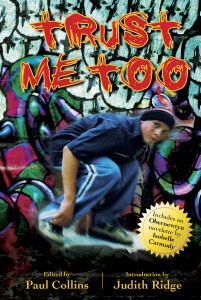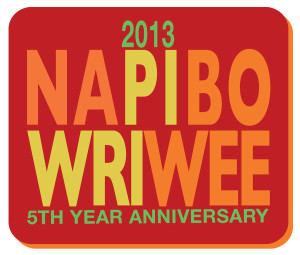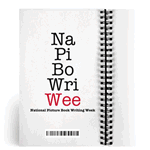NAPIBOWRIWEE 2013: Day 5 – Guest Blogger Paul Collins! (May 5, 2013)
Welcome to DAY FIVE of NAPIBOWRIWEE 2013! By now, I bet you’re wondering why you even signed up for this crazy event where we attempt to write 7 picture books in 7 days. The burn out really kicks in around Day 5. We all see talking animals in our sleep. We can’t help but speak in rhyme every time we pick up the phone. We are starting to hallucinate and think that a picture book about house mortgage payments might actually be a good idea…
LOL! HANG IN THERE! Today is the day that you should treat yourself to something special for having made it to Day 5. Treat yourself to a favorite icy cold drink at your local coffeehouse. Go ahead, buy that guilty pleasure candy bar at the check-out counter at the grocery store. Order a pizza or your favorite food from a nearby restaurant instead of cooking tonight! Or go to your favorite independent bookstore and buy yourself a beautiful picture book! Or just veg out in front of the TV and watch a guilty pleasure show. 🙂
By giving yourself a little treat or pat on the back, you will have lifted your spirits and refreshed your energy to DIG IN FOR THESE LAST FEW DAYS! I am very proud of everyone and have enjoyed reading your comments. I’m sorry I haven’t had a chance to reply individually to your comments because of my work schedule, but trust me, I’ve read every single one! You guys are amazing!
MY DAY FOUR EXPERIENCE: Hopefully most of you had Saturday off. That way, you could sleep in and then have the luxury of spending a lazy Saturday working on Picture Book #4.
For me, I did have one last work deadline to finish before I could start Book 4. I had to some line edits for my next picture book that will be published by LEE & LOW BOOKS. (This book is still top secret and under wraps, but I will be able to reveal some details about it soon, so stay tuned.)
Doing line edits on this book was a humbling experience. Every time I think I’ve “nailed” the whole Writing A Picture Book process, my brilliant genius editor offers a revision suggestion or does an amazing cut that takes the book to the next level. I’m this close to banging my head against the wall, wondering, “Why didn’t I come up with that genius idea?” Lesson Learned: You Will Always Learn And Grow As A Writer, No Matter How Many Books You Write (And Hopefully Publish). I was stunned today by my editor’s insights and thoughtful revision cuts and simplifications.
Writing a picture book is like writing a haiku – not one word should be wasted. Every word is a jewel. The simplest text often reveals a rich and deep verbal picture that is enhanced by the artist’s illustrations. I’m honored and privileged to work with my editor whose editorial critiques are helping me become a better writer.
Unfortunately, my genius editor was not around today to help me when I started writing the rough first draft of a new picture book for Day Four of NAPIBOWRIWEE. LOL! 😛 🙂 So what I wrote is really, really, REALLY ROUGH.
But now I can apply what my editor taught me when I return to Book No. 4 for revisions. 🙂 And what was Book 4 about? Let’s just say that I posted this picture of one of my three cats (Oreo) lounging around all day on Twitter and it totally inspired a fun little poem. (You can follow Oreo on Twitter @oreothecatyoo).

The only problem with Book Four? POETRY. IS. HAAAARD!!!!!
So to inspire those of you who are doing poetry picture books, here’s a link to some amazing articles for writers on how to write poetry and picture books acclaimed picture book author and poet HOPE VESTERGAARD (http://hopevestergaard.com). She has done past guest blogs in the past in earlier NAPIBOWRIWEE years, too.
Please go here to check out her articles on how to write poetry and picture books here:
http://hopevestergaard.com/writers/articles/
I especially recommend this one on RHYMES AND MISDEMEANORS:
http://hopevestergaard.com/writers/articles/rhymes-and-misdemeanors/
######
In the meantime, to keep us inspired and on our toes, today’s guest blog is with Ford Street publisher and author PAUL COLLINS (http://www.paulcollins.com.au). He is one of TWO Australian authors we are interviewing this year. We have an international contingent of writers who participate every year in NAPIBOWRIWEE, including a fantastic group of writers from Down Under. So I’m thrilled we have Paul on board for this year. Please comment on today’s blog with your thoughts on Paul’s Q&A as well as your own progress reports of your picture book writing efforts!
(Keep reading after the jump for our Q&A on the Future of the Picture Book with Paul Collins!)
GUEST BLOG – DAY FIVE – PAUL COLLINS
PAUL COLLINS‘ many books for young people include TRUST ME TOO, which he edited (just selected as a White Raven 2013 title). Trust Me Too. It comprises over 50 of Australia’s leading authors and illustrators including Susanne Gervay, Leigh Hobbs, Marc McBride and Isobelle Carmody. It’s been chosen as a White Raven and was a Notable in the Children’s Book Council of Australia awards. He is also the author of series such as THE JELINDEL CHRONICLES, THE EARTHBORN WARS, THE QUENTARIS CHRONICLES and THE WORLD OF GRRYM in collaboration with Danny Willis. His latest is THE MAXIMUS BLACK FILES (Mole Hunt and Dyson’s Drop with The Only Game in the Galaxy due soon). The trailers are available here: http://www.youtube.com/watch?v=3S-eKDYqpEs and http://www.youtube.com/watch?v=n4tTn_WXCiw He is also the author of over 150+ short stories. Paul’s picture books are HOME RUN, illustrated by Connah Brecon and THE GLASSHOUSE, illustrated by Jo Thompson. Paul has been the recipient of the A Bertram Chandler, Aurealis, William Atheling and Peter McNamara awards and has been shortlisted for many others including the Speech Pathology, Mary Grant Bruce, Ditmar and Chronos awards.
He is currently the publisher at Ford Street Publishing (www.fordstreetpublishing.com) and runs the speakers agency Creative Net (www.fordstreetpublishing.com/cnet). Visit him at www.paulcollins.com.au.
Q&A ABOUT THE FUTURE OF THE PICTURE BOOK WITH PAUL COLLINS

QUESTION: Do you think the rise in popularity for the eBook will help or hurt the future of the picture book? For writers, when you work on a new book, do you think about how it will “read” on an eBook reader as well? Does that affect how you write your book? For illustrators, what challenges do you face if you know a picture book you are illustrating may also be distributed as an eBook?
ANSWER: I think kids have really taken to e-readers. I was at a party a few weeks ago and a three-year-old was totally engrossed in his e-reader with an interactive picture book on it. I doubt that would’ve happened if it had been a print book.
QUESTION: There have been many “Boy Who Cried Wolf” articles in the media recently about how picture book sales have declined as anxious parents try to push their students into reading chapter books instead. Why is it important for children to read picture books? What makes a picture book special as well as important for a child’s educational growth?
ANSWER: Not all kids have the same reading ability. Wipe out picture books and you’re wiping out a generation of kids who might have become readers had they been given the graphic opportunity. I read Marvel Group comics as a kid. I hadn’t read a book till I turned 16 or 17. If there hadn’t been comics I wouldn’t have turned out a reader. Here I am now, a publisher and an author.
QUESTION: Many aspiring picture book writers are discouraged by the doom-n-gloom reports of the declining book industry (Big Six mergers, lower sales of picture books, more emphasis on the writer-illustrator as opposed to the solo writer). What words of encouragement would you give to these aspiring newbies to NOT give up?
ANSWER: Success in any endeavour is about persistence. Of course there are hurdles — every occupation has them. I’ve faced a lot of adversity over the years — but every set back made me more determined to succeed. The good thing about writing for children as opposed to writing for adults, is that children’s writers/illustrators have both the school market as well as the adult market. Schools and adults generally buy books for the kids, not to mention the kids themselves to a lesser extent. So you basically have three markets in which to sell your books.
QUESTION: What challenges do you face as a published author of picture books in these volatile times of the publishing industry? Have you noticed a change in your career in terms of what agents/editors/readers want?
ANSWER: I think publishers are after multi-levelled books — that is, picture books that aren’t just stories, but they have depth. You’ll see teachers’ notes on many major publishers’ websites. It’s pretty hard to writer teachers’ notes or promote a book to schools if it’s just a simple story with no depth/levels.
QUESTION: Any final words of advice or any epiphanies you would like to share with us about your own writing/art journey?
ANSWER: I’m still not a strong reader, and strange though it may seem, I think that’s what gives me a slight edge over well-read editors. A book has to be really good to get my attention. I’m not interested in the fact that the writing is supposedly great, I’m interested in the story itself. Oscar and Lucinda by Peter Carey won awards and was critically acclaimed, but I don’t know a single person who managed to finish it. That’s not the type of book that I would publish. Subsequently, a lot of major publishers are rejecting books that people do want to buy and read. I’ve published many books that were rejected by other publishers only to get short-listed for premier’s awards and sell well. My own picture book, The Glasshouse, was rejected by just about every major publisher in Australia, so I published it via Ford Street. It sold 4000 copies to a book club, was selected as an Outstanding Book For Young People With Disabilities, 2011 by the International Board on Books for Young People (IBBY) Awards and the illustrator, Jo Thompson, was short-listed for the Crichton Award. Persistence is the key.
######
Thanks again to Paul Collins for answering our Q&A for Day Five!
Tune in tomorrow by 6 AM (West Coast Time) for our Day Six Blog featuring author and fellow Aussie down under TANIA MCCARTNEY (http://www.taniamccartney.com)!
In the meantime, good luck writing today. Please post any comments below for today’s blog with your thoughts, questions, and writing updates. You can follow me on Twitter @paulayoo. Please feel free to use this HASHTAG – #NaPiBoWriWee
I’m off to write! Until tomorrow’s blog, remember… HAPPY WRITING! WRITE LIKE YOU MEAN IT! 🙂



I love this potent reminder: “Success in any endeavour is about persistence.” We’re absorbed in writing and illustrating, but this is true of any craft that requires skill development and revision!
I too feel that the story is the reason I would buy the story rather than just the ‘supposedly’ good writing. I was so against e-readers – thought they were a big waste and would never takeoff. I was wrong. Kids are glued to these every where I go. I was at McDonalds and instead of playing with the toy in her Happy Meal, a girl of about 6 was glued to the screen of her e-reader!
Thanks for your encouraging words! I wrote a very rough draft again, but I think it has potential. Yay!
My 6th and 7th drafts are finished! I really wanted to add another completed draft to my count, and may do that later this afternoon, but for now I’m headed outside and will join Canoe in catching some rays. Won’t get much done tomorrow as I will once again be glued to the computer watching the Badminton Show Jumping coverage live on FEI
I used picture books to kick off my themes when I was teaching the primary grades. I would search for books to match my curriculum standards.
Authors and illustrators do not realize the impact they make on students with their stories. The teacher is the chief promoter of books. When they took away thematic teaching, teachers stopped buying books at the bookstores.
I know teachers will talk about the art on the book pages about the media and “what’s going here?” with the children. They get excited for the next page.
Some will recognize the illustrator’s style.
Thank you for sharing your thoughts about teacher notes and the challenges in the publishing industry.
Paul’s comments on not being a strong reader serve as a good reminder that the reader of our stories is so important and those readers are all so different.
Can’t believe it’s DAY 5 already. I wrote a 1st draft– tried something new for me (took an old, somewhat obscure fairy tale and rewrote it with kids instead of animal characters– needs lots of work but was a fun exercise).
Thanks to Paul & Paula for an interesting interview!
I wholeheartedly agree with your statement, “Success in any endeavour is about persistence.” As President Calvin Coolidge (who, like myself, is a Vermonter) once said, “Nothing in this world can take the place of persistence. Talent will not; nothing is more common than unsuccessful people with talent. Genius will not; unrewarded genius is almost a proverb. Education will not; the world is full of educated derelicts. Persistence and determination alone are omnipotent. The slogan “press on” has solved, and always will solve, the problems of the human race.”
And I have tons of books filling up my bookshelves where the writing wasn’t “top drawer,” but the storyline had me hooked from the very first page.
Fell asleep on top of yesterday’s draft. I hope to finish it as well as draft #5 by midnight.
Amazing editorial advice, Paula. Just remember whose “genius idea” the editor is helping revise. Please consider posting some of those stunning revisions after the book is published to make us better self-editors.
Wow, Paul. Thank-you for your insight about reluctant readers, writing from a teacher’s perspective, and encouragement to continue what we are passionate about.
I really enjoyed Paul’s responses, very real and true also for those of us who have been enjoying the surge in great teen lit. Paula, love your quote: writing a picture is like writing haiku.
Day 5 draft is the cruddiest of all- but I am still going 🙂
I am so impressed with everyone who has 5 pb drafts completed! I am only at 3, but I’m getting lots of great ideas for more as I go.
Thanks for the persistence push, Paul! I am just starting my Day 5 draft now.
Okay. #4 & 5 drafts are done. Not even sure these are picture books (also seem more like chapter books, but we’ll see.) But most importantly—I broke my day four slump!
Thanks for the tips and tricks about writing rhythms.I am definitely bookmarking that for later.I am still burned out from yesterday so I just couldn’t think of a new idea so I have been just working on my 3rd and 4th ideas.And neither of them are done but I am getting closer XD.
A day late land a dollar short. I read the post yesterday, had to leave for the day, and wrote not write anything. I thought and thought all day on what to write and wrote it on Mon. May 6. Now on to today’s story. I love the post.
This was the first response about e-readers that sees them as just as much of a big hit with the kids as PB’s. Now, I agree I’d rather cozy up with a book and turn pages even if you have to maneuver the book past your belly to do those page turns with blankets getting caught up in the corner of the book and your wrists getting tired. Still there is something addicting about paper and ink, yes?
I’m a mother of 6 grown children and grand mother of 2. My little, Anna, just 4 is always on daddy’s “book” but the other day her Aunt took a picture of her with the Etch-A-Sketch atop the I-pad. It was adorable.
I believe there will always be room for both, unless we run out of electricity some day.
Thanks for the post.
And speaking of posts I think I’ll lift the picture off the family Facebook page and send it over to my blog. You can check it out.
http://www.zebrakitchen.blogspot.com
Playing a little catch-up today. Didn’t have the time on Sunday. Thanks for your insight, Paul. Persistence and patience, I have a lot more now than I did when I first started this children’s writing thing!
Paula, it must be awesome to work with an editor who is so crafty and creative with revisions.
I agree with Paul about stories having more depth, and I hope he is right about publishers looking for that type of book. As a teacher I always looked for meaty stories.